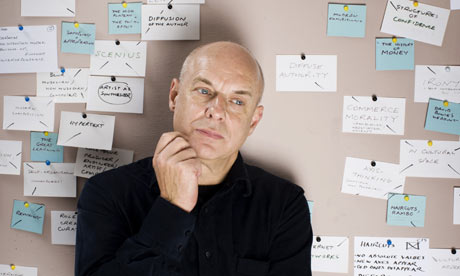 Brian Eno’s Music for Airports (1978) played a very important part in the concept and development of ambient music. One could say that ambient music is not a music to be listened to, but a music to be heard, as a subliminal background creating a soundscape for various places or buildings. Supermarkets and elevators are usually places where a poor music is played, one calls it muzak. Brian Eno’s idea was to conceive a sophisticated musical soundscape instead of this anonymous FM music, and he chose airports as the best places where such a music could be heard and understood, creating an unusual and quiet sonic background among all the noises and announcements of a airport terminal.
Brian Eno’s Music for Airports (1978) played a very important part in the concept and development of ambient music. One could say that ambient music is not a music to be listened to, but a music to be heard, as a subliminal background creating a soundscape for various places or buildings. Supermarkets and elevators are usually places where a poor music is played, one calls it muzak. Brian Eno’s idea was to conceive a sophisticated musical soundscape instead of this anonymous FM music, and he chose airports as the best places where such a music could be heard and understood, creating an unusual and quiet sonic background among all the noises and announcements of a airport terminal.
Music for Airports is a masterpiece, with its subtle piano tracks, its complex electronic treatments, its choral parts, and its slow and organic development.
In 1998, Point Music, a label directed by Philip Glass, released this amazing interpretation of Music for Airports by Bang on a Can: Robert Black (bass), Lisa Moore (piano, keyboards), Evan Ziporyn (clarinet, bass clarinet), Maya Beiser (cello), Steven Schick (percussion), a choir of female voices and additional musicians playing pipa, flute, horn, trumpet, trombone, violin, cello, mandolin and mandocello.
This chamber music ensemble plays Eno’s compositions with fidelity and creativity at the same times. The acoustic instruments create a rich harmonic soundscape and add a very original touch to the original recording.
This peaceful, quiet and slow music is very evocative and poetic: the cover version is as beautiful as the original…
Excerpt from Brian Eno – Music for Airports 1.1 – played by Bang on a Can
Via Just Another Garden

 Paul Morley recently spoke to Brian Eno for a BBC arena documentary in which Eno proved that he is always good for a controversial and catchy phrase about the music industry:
Paul Morley recently spoke to Brian Eno for a BBC arena documentary in which Eno proved that he is always good for a controversial and catchy phrase about the music industry: Bloom, Trope and Air are three applications developed by Brian Eno and the musician / software designer Peter Chilvers that brings to the iPhone the concept of generative music popularized by Eno.
Bloom, Trope and Air are three applications developed by Brian Eno and the musician / software designer Peter Chilvers that brings to the iPhone the concept of generative music popularized by Eno.
 Ok, un po’ di tranquillità dopo lo sforzo organizzativo del Premio Nazionale delle Arti.
Ok, un po’ di tranquillità dopo lo sforzo organizzativo del Premio Nazionale delle Arti.
 Brian Eno’s
Brian Eno’s 